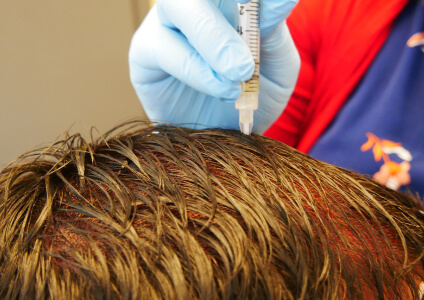Platelet Rich Plasma (PRP) Hair Restoration

Hair loss can happen for a variety of reasons such as stress, genetics, hormonal imbalances, medications, age, poor nutrition, and other medical conditions. It can happen fast or gradually.
For anyone who has experienced it, there can be grief, sadness, embarrassment, shame and jealousy of those who have all their hair.
While, or even after, the root cause(s) of the hair loss are being addressed (if possible), PRP injections may help stimulate hair growth by providing nutrients and growth factors directly into hair follicles.
What are PRP injections:
PRP is an injection modality that uses a patient’s own blood to promote regeneration and healing. Blood has four main components: erythrocytes (red blood cells or RBCs), leukocytes (white blood cells or WBCs), platelets, and Plasma.
PRP uses the last two elements, Platelets and Plasma. Plasma is a liquid portion of blood, which is made up of enzymes, salts, and water. Its primary job is to transport nutrients, proteins, vitamins, and hormones throughout the body and to help eliminate waste products.
Platelets are tiny fragments of cells that are responsible for helping to clot and stop bleeding; beyond this, they also contain a variety of growth factors that help stimulate healing of tissue.
When blood is spun down via a high-powered centrifuge, the components can be separated. This allows us to get a high concentration of platelets in a small amount of plasma for use in injections.
What can PRP be helpful for:
PRP injections can be used for those with persistent injuries of tendons, ligaments, muscles, and joints, degenerative conditions such as osteoarthritis, and hair restoration for those with natural hair loss. The only PRP injections we are currently offering at our clinics is PRP for hair restoration.
PRP Injections:
One of the services offered here at NFM Health, Inc. by Dr. Sabin Gilman and Dr. Krystal Richardson is PRP injections of the scalp. This involves using a needle to get a large blood sample from a patient.
It is then centrifuged and processed to create a high concentration of the patient’s platelets. The area is numbed and then the solution is then injected directly into the scalp with a small needle. The goals are to stimulate hair growth by providing nutrients and growth factors directly into hair follicles.
Risks/contraindications:
It is not a therapy for every person. There are, of course, some risks, which will be discussed in detail with each patient as well as some contraindications, which can be case dependent. Some potential risks are worsening hair loss (much like “shedding” caused by hair-growth products), bleeding/bruising, allergic reaction, etc. Contraindications include, but are not limited to, pregnancy, uncontrolled diabetes, infection, skin infections, inflammatory/autoimmune arthritis, and allergy to the solution used as part of the injection.
What to expect:
The first appointment will typically involve obtaining a solid medical history; assessing the areas of concern; making a diagnosis if one has not been made; addressing root causes; reviewing contradictions, risks, benefits; and developing a plan.
The earliest the scalp will be injected will be the second appointment, which can last 2-3 hours. We will first draw your blood and then prepare the solution. There will be an option to have a topical numbing agent or nerve block to help with pain. The scalp will then be injected until there is no solution left. This could take 50 or more injections.
There might be some minor discomfort during this process, but it shouldn’t be painful. Once the numbing agent wears off, there might be increased pain. The area will look wet, discolored/bloody. You will want to cover the area with plastic after the procedure to protect it from the sun and the environment. The injection points are “micro injuries” that need to be protected to prevent infection. The scalp may become itchy as it heals and will develop scabs. Do not wash your hair for at least 24 hours.
It will take 3-6 injections, spread out over 4 weeks, to see any difference. Once hair growth is obtained, it will then take 1-2 injections a year to maintain the growth.
Success is dependent on many factors, such as general health and nutritional status. PRP will not give you what you’ve never had: It will not grow hair where it’s never existed.
Price/Insurance:
PRP injections are a separate charge outside of the visit cost. Insurances do not cover them, but we can/will bill them for the visit portion. The cost is $500 per session.
Schedule Your Appointment Today
Our Locations:
Donec id elit non mi porta gravida at eget metus. Nullam id dolor id nibh ultricies vehicula ut id elit. Aenean lacinia bibendum nulla sed consectetur. Maecenas sed diam eget risus varius blandit sit amet non magna.
Receive health tips, insightful articles, and our latest updates by joining the list.
